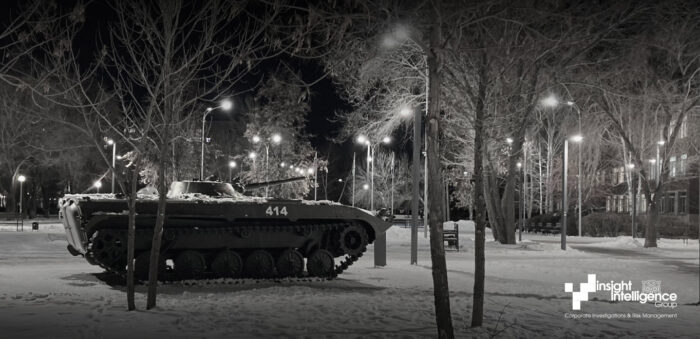The “Hot War” of World War II came to an end on September 2, 1945, with Japan’s surrender. Three days later, on the evening of September 5, the Cold War—or, at least, the end of it—was declared.
A month after Japan’s surrender, Igor Sergeievich Gouzenko, a junior diplomat at the Soviet Embassy in Ottawa, sought to flee to Canada with various documents he had acquired from the embassy.
He brought several documents with him, the most of which were written in Russian and proved the existence of a Soviet spy ring in Canada.
He had no clue his activities would spark a major post-war crisis.
Igor Sergeievich Gouzenko, who is he?
Igor Sergeievic Guzenko was born in 1919 in Rahachovo, Belarus, former USSR. During WWII, he was a cryptography officer. In 1943, he was transferred to Ottawa, where he worked in the Soviet Embassy until 1945. This work gave him access to a number of documents proving Soviet spying.
The man in question, Igor Sergeievich Guzenko, was more than a junior diplomat: he was a member of the Main Intelligence Directorate (GRU), the Soviet military’s foreign military intelligence agency.
As part of the Soviet mission in Ottawa, his primary responsibilities included encrypting and decrypting messages for the GRU’s chief in Ottawa, Colonel Nikolai Zabotin, who led a network of operatives in Canada who gathered intelligence for the Soviet Union under the guise of a Soviet military attache.
Guzenko opted to emigrate after realising that he might be forced to return to the Soviet Union. He crossed the border into Canada on September 5, 1945, with 109 documents exposing Soviet espionage operations in the West.
Because of his profession, he had access to several documents proving Soviet espionage. Stalin’s ambitions to collect nuclear trade secrets, as well as his employment of sleeper operatives, were revealed by Gouzenko.
The “Gouzenko Affair” is commonly cited as the starting point for “Cold War” events.
Guzenko worked in the cypher section of the Soviet embassy in Ottawa during the height of World War II in 1943. Colonel Zabotin, the Soviet military attaché at the embassy, was the commander of many spy rings working in Canada, he discovered.
He deserted to the Canadian side in 1945 after learning that he and his family would be sent to the Soviet Union. He took that decision primarily because of the Soviet Union’s dismal economic conditions and political ideals with which he disagreed. Gouzenko left the embassy with a briefcase full of Soviet decoding tools and code books.
Nobody was taking him seriously.
He initially went to the Canadian Police, but none of the officers took him seriously.
When he went there, the night editor of the Ottawa Jurnal seemed unconcerned and recommended him to contact the Department of Justice instead. When he came, there was no one in control.
He returns to his flat and hides his family for fear that Soviet spies will discover his betrayal. While hiding at a neighbor’s house, Gouzenko witnesses a group of Soviet spies breaking into his home via a keyhole. They scoured the area until the cops arrived.
In the 24 hours following his evacuation from the embassy, Gouzenko went from pillar to post, attempting to tell his story to the news media, the police, and the government. He appeared to have been thwarted at every turn. People assumed he was lying, that he should be dealt with by someone else, or that recognising him would cause too many problems with the Soviets.
The next day, Gouzenko was able to make contact with police officers who were ready to look into the material he had stolen from the Soviet Embassy.
Authorities took Gouzenko to a secret “Camp X” that was used to train covert spies during WWII. Gouzenko was questioned by British MI5 and American FBI investigators while there. The CIA was being sabotaged at the time.
Canadian Prime Minister Mackenzie King was initially opposed to it, fearing that it would sour relations with the Soviet Union, Canada’s partner in World War II at the time.
When Deputy Secretary Norman Roberson presented the Prime Minister with these data, he was shocked, but he insisted on doing nothing. Even after Robertson notified King that Gouzenko was threatening suicide, King was adamant that the government not get involved, even if the Soviet authorities arrested him.
Despite the prime minister’s protests, Robertson allowed Gouzenko and his family refuge on the grounds that they were in danger of being killed.
The public was astonished when news came about Soviet operators in an espionage network in Canada, where Canadians were providing confidential intelligence to the Soviet government. Because Canada was a key player in early nuclear weapons research, the authorities were anxious that other countries would gain access to the technology.
Gouzenko’s information led to the arrest of 39 people, 18 of whom were convicted on various crimes. Among the defendants were Fred Rose, Canada’s lone communist member of Parliament, Sam Carr, the Communist Party’s state organiser, and scientist Raymond Boyer.
This episode acted as a warning to other countries, primarily the United Kingdom and the United States, that Soviet operatives were present. Gouzenko’s testimony was crucial in exposing Klaus Fuchs, a German physicist who moved to the United Kingdom and later acquired atomic bomb secrets before handing them over to the Soviets. He is thought to have played a key role in the investigations of Julis and Ethel Rosenberg in the United States, as well as the finding of critical Soviet spies in the United Kingdom, such as the Cambridge Five.
Gouzenko had a few televised appearances, although he always wore a white cap to conceal his identity. He also wrote two books.
Following this occurrence, the connection between the East and the West entirely cooled. Despite never engaging in direct battle, the USSR and the US began a number of conflicts. When the Soviet Union disintegrated in 1991, the “Cold War” was officially declared over.



